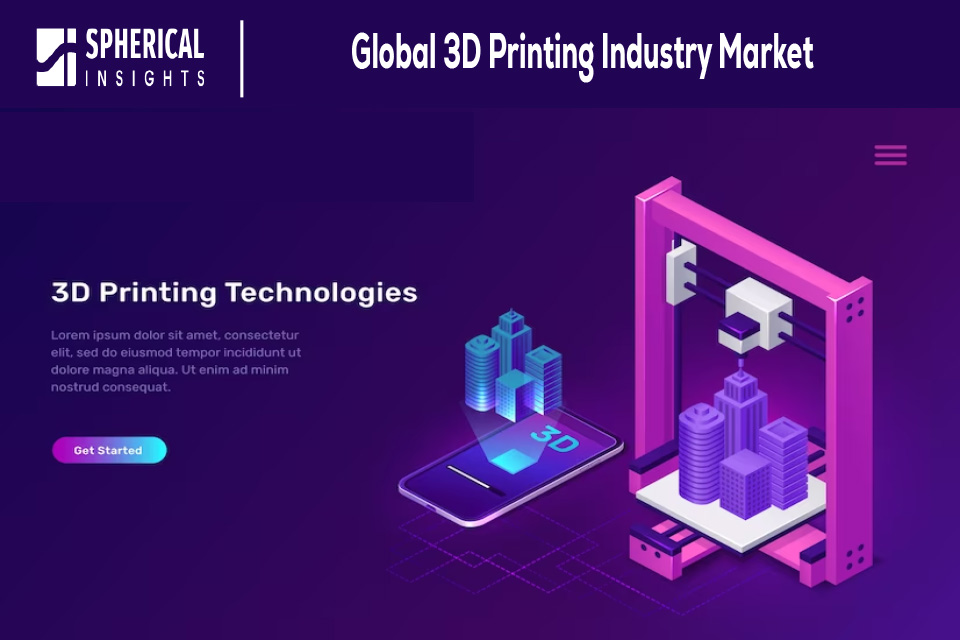
What Are the Top 3D Printing Industry Trends in 2023? What Will Be Market In Coming Years?
RELEASE DATE: Aug 2023 Author: Spherical InsightsRequest Free Sample Speak to Analyst
A wider range of printable materials, such as metals, ceramics, composites, and others, were becoming available for 3D printing. The availability of more material possibilities has increased creativity and flexibility in producing robust and useful 3D-printed things. Numerous sectors, including manufacturing, aerospace, automotive, and healthcare, are using 3D printing more frequently. Businesses were using the technology for rapid prototyping, specialised manufacturing, and even the fabrication of end-use parts. With improvements in technology and equipment, it was becoming more practical to print larger items or components. This development could have an effect on sectors like construction, where 3D printing for infrastructure and building structures was being investigated. Now, let us have a look at the top 3D Printing Industry Trends in 2023:
The Global 3D Printing Market Size in terms of revenue was estimated to be worth USD 15.76 billion in 2023 and is poised to reach USD 90.5 billion by 2032, growing at a CAGR of 25.1% from 2023 to 2032, according to a new report by Spherical Insights LLP. The new research study consists of an industry trend analysis of the market.
Use Cases of 3D Printing are in High Demand
3D printing is used by the aerospace industry to produce efficient, lightweight, and complicated parts for aeroplanes and spacecraft. This covers structural elements, engine parts, and even full prototypes. By making it possible to design implants, prosthetics, surgical guides, anatomical models for preoperative planning, and even bioprinting for regenerative medicine, 3D printing has transformed healthcare. Rapid prototyping, the creation of customised parts, and even the production of lightweight parts that improve performance and fuel economy are all possible due to 3D printing in the automotive industry. Rapid prototyping, the creation of customised parts, and even the production of lightweight parts that improve performance and fuel economy are all possible thanks to 3D printing in the automotive industry. Complex architectural models, full-scale building prototypes, and even practical construction components like concrete walls and structural elements are being produced using large-scale 3D printers.
The Growth of 3D Printing is Higher Than Others
Significant development was being driven by the widespread adoption of 3D printing in sectors like aerospace, automotive, healthcare, and consumer goods. The market was anticipated to grow as more industries realised the advantages of 3D printing for quick prototyping, customization, and effective production. The variety of uses has increased with the introduction of new and improved 3D printing materials, including metals, ceramics, and sophisticated polymers. More industries were drawn to it due to its adaptability, which helped the market expand. The attraction of 3D printing has increased as a result of advancements in the field, including quicker printing rates, greater build volumes, and more precision. The production of patient-specific implants, surgical guides, and prostheses via 3D printing is becoming increasingly popular in the medical and healthcare fields. A new generation of knowledgeable designers, engineers, and innovators was being fostered by the inclusion of 3D printing in academic curricula. This was encouraging for the future of the sector.
Brands are Adopting 3D Printing Technology
Brands can quickly produce prototypes and iterate on designs due to 3D printing. This facilitates a quicker time to market for new items and accelerates the product development process. Brands have the ability to give their customers highly individualised and personalised products. Increased client pleasure and loyalty may result from the capacity to produce distinctive goods that are customised to specific desires. Complex and elaborate designs can be produced with 3D printing, which would otherwise be impossible or very expensive to do so using conventional manufacturing techniques. This promotes distinctive product design strategies and design innovation. By 3D printing components on demand, brands may lessen their dependency on convoluted supply networks. Lead times can be shortened and supply chain interruptions can be lessened as a result. Brands can tailor-made tooling, jigs, and fittings using 3D printing.
Rise in Digital Supply Chain
Digital supply chains make it possible for geographically separated teams to work together on product creation without the need to ship physical prototypes back and forth. Delays are cut down, and decision-making is accelerated. To attain economies of scale, traditional supply chains frequently use large-scale production runs. With the use of 3D printing, things may be produced as needed, eliminating the need for large warehouses and extra inventory. Manufacturing can be localised or dispersed thanks to 3D printing. Products can be printed nearer to the site of consumption rather than relying on centralised factories, lowering transportation costs and carbon footprint. Digital files for 3D printed objects can be used as virtual inventory in place of real inventory. To reduce excess and waste, products are only produced in response to orders.
Quality Assurance as the Foundation of 3D Printing Industry Growth
When it comes to 3D printing materials, quality control is the first step. The materials' consistency in characteristics and compliance with established criteria are the responsibility of the manufacturers. Testing materials entails determining whether they are appropriate for the intended purpose by examining aspects including mechanical strength, thermal characteristics, and chemical resistance. For precise and dependable results, 3D printers must be regularly calibrated and maintained. A variance in the final printed pieces can be avoided by checking that the printer is functioning within the prescribed tolerances.
Need help to buy this report?